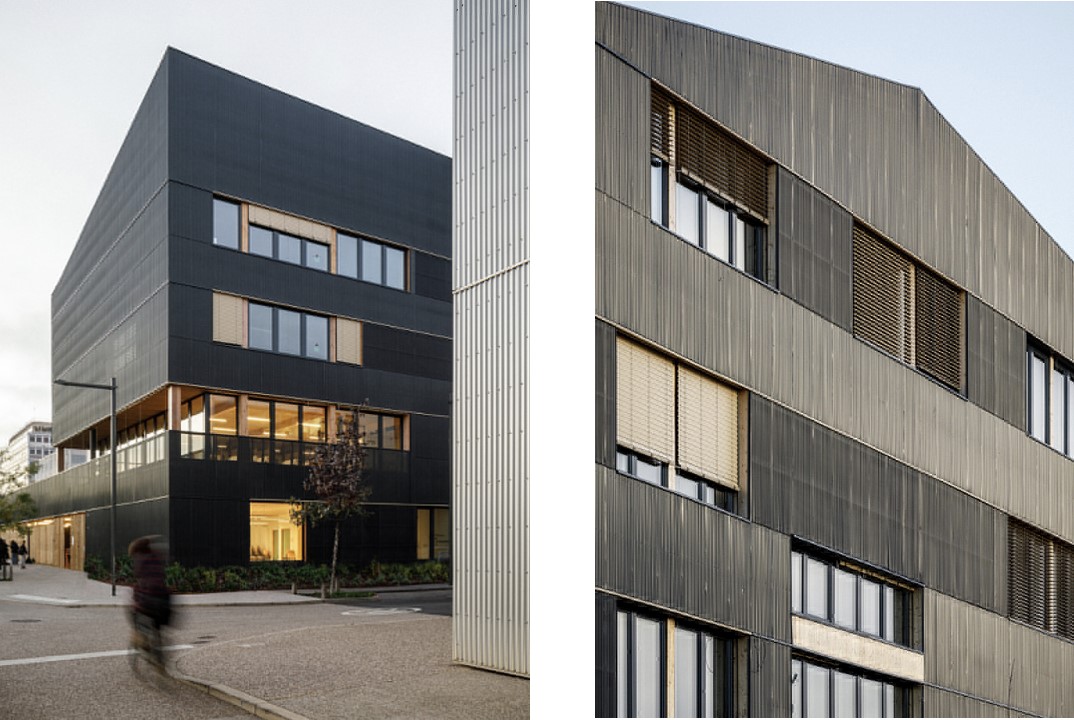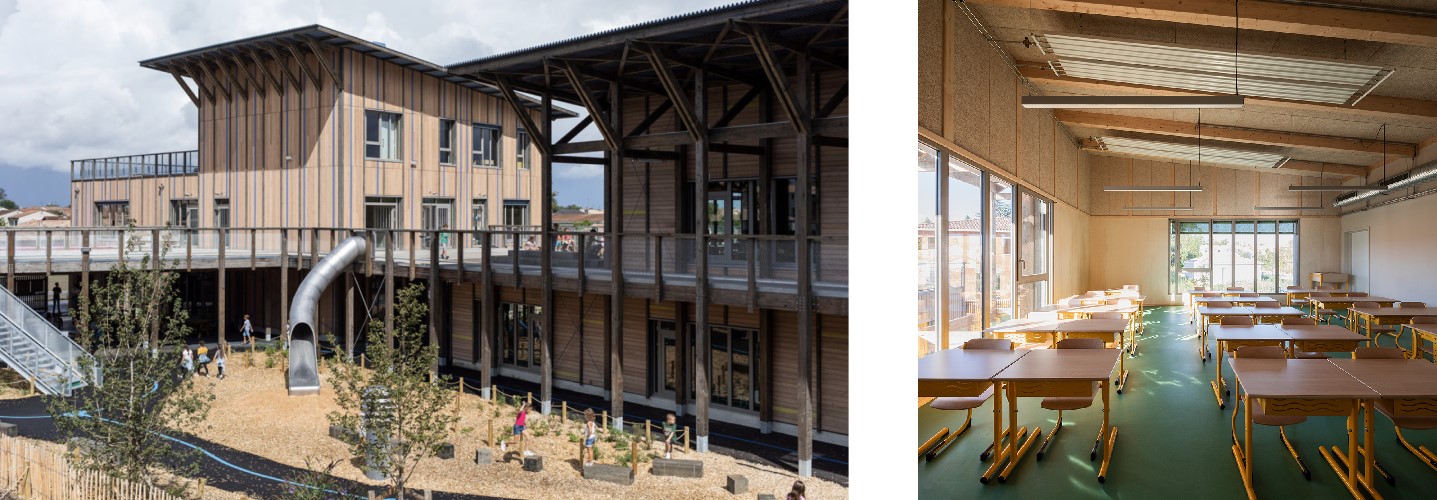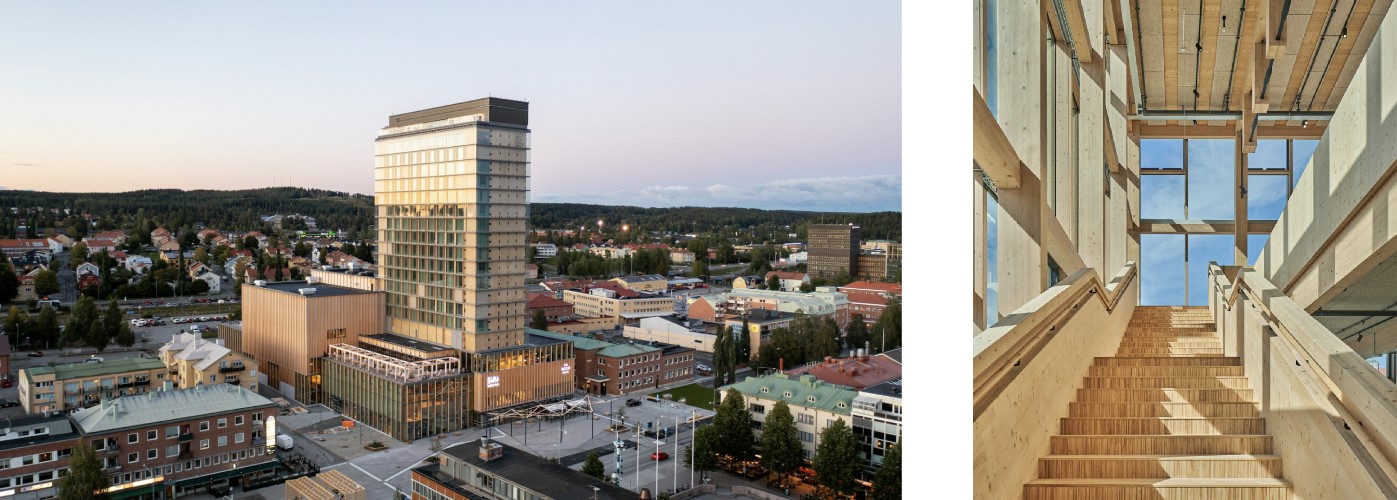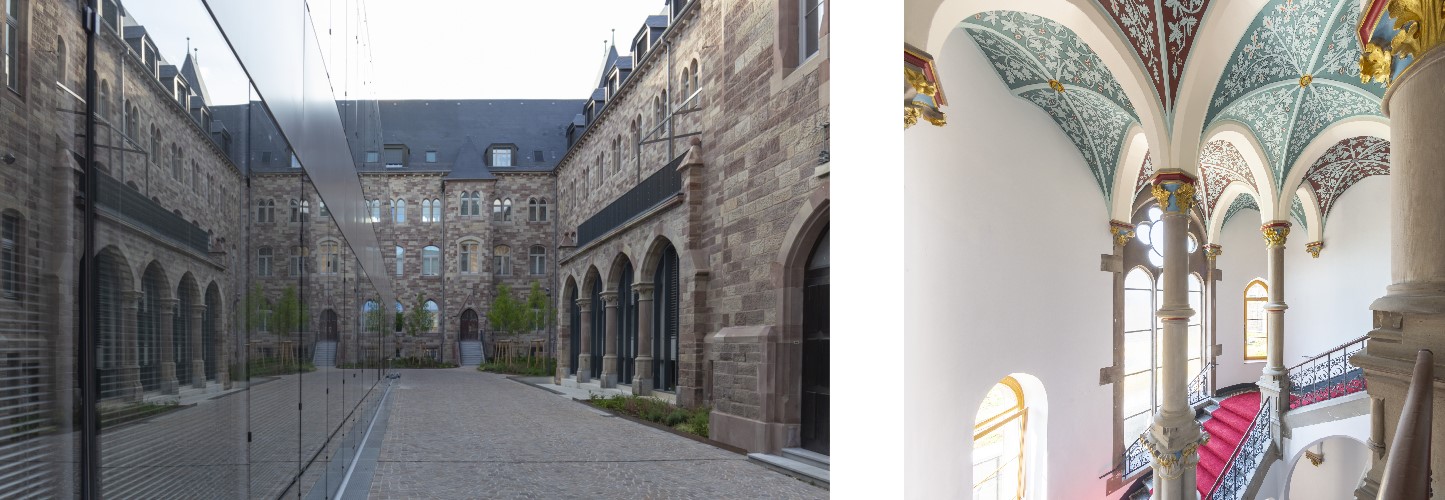Subject file #2 Decarbonising buildings - Section 2: Focus on 9 low-carbon projects and achievements

When it comes to low-carbon construction and building renovation, there are now plenty of sources of inspiration. Even though the regulations are recent, many new buildings and renovations are already adopting this approach. Housing, office buildings, schools and colleges, stadiums, neighbourhood regeneration schemes, hosting infrastructure for the 2024 Paris Olympics, new-build or renovation, urban or rural, public or private, projects in progress or completed several years ago… Explore a selection of nine French and European projects.
Eco Park Stadium (Eastington - Gloucestershire - United Kingdom)
Dale Vince, founder of Ecotricity (a British renewable energy company) and chairman of Forest Green Rovers FC, an EFL League 2 club, has obtained planning permission for a 5,000-seat stadium built entirely of wood – the Eco Park Stadium, with plans designed by Zaha Hadid Architects.
Its undulating organic spaces will be realised by a narrow framework of glulam timber beams. Rather than cladding the roof, the firm went for a lightweight transparent membrane canopy that will reduce CO₂ emissions during construction by 30%.
Taking the building's life cycle into account, the project design will make it possible to reduce emissions to around 200 kg of CO2 equivalent per seat, whereas most stadiums have emissions of 360 to 1,300 kg per seat. The scalable project is designed to allow potential expansion to house 10,000 fans. Goooooaaaal for the energy transition in 2026! To find out more about the project, click here.

© Zaha Hadid Architects
Collège Niki de Saint-Phalle (Nancy - Meurthe-et-Moselle - France)
The first positive-energy school in France's Grand Est region, and the first four-storey public building made of timber and straw in France, the Collège Niki de Saint-Phalle places maximum emphasis on environmental criteria: timber-frame walls, insulation made of local straw combined with cotton wool and cellulose fibre, PassivHaus construction and a connection to the urban heat network.
The MU Architecture firm searched all of Lorraine to identify straw producers who could contribute to the building. Bundles 36 centimetres thick made it necessary to develop a suitable timber frame, giving the carpenters the chance to gain experience with the use of straw.
Anticipating the likely increase in rainfall over the coming years, the specifications required 100% of rainwater to be absorbed on site. Two solutions made this possible: beneath the sports field, a “reservoir” of limestone pebbles provides retention for 172 m³ of water, while the green roof can store 35 m³ of water to extend the permeation time. The whole project looks like an ecology lesson! To find out more about the project, click here.

© MU Architecture
Frida Khalo SCHOOL COMPLEX (Bruges - Gironde - France)
Frida Kahlo is one of the first schools in France to be granted the E4C2 label, which is the most demanding in terms of energy performance and greenhouse gas reductions. The school complex was designed by Compagnie Archi as an innovative educational tool that would turn pupils into citizens who are sensitive to and engaged with environmental preservation. It is divided into five “houses” placed around kitchen gardens and a wooded playground, accessed by walkways, passages and… a slide!
To raise pupils' awareness of ecology, the way the school works is made visible and understandable through the use of exposed materials: timber structure, timber cladding, timber joinery, timber absorbency. Electricity is generated by solar panels on the roof and the wood-fired boiler is fed with deliveries to the car park in front of the school. The whole operation is an open book!
To find out more about the project, click here.

© Compagnie architecture
Paris 2024 ATHLetes' village (Saint-Denis - Seine-Saint-Denis - France)
In response to the low-carbon ambitions of Paris 2024, all the companies involved in building the athletes' village have had to innovate and test methods that will become widespread as the RE 2020 environmental regulation is applied. To control the carbon budget, large-scale use has been made of biobased materials such as timber: of the 280,000 m² of surface area, 200,000 m² have timber façades and 80,000 m² have timber structures. And what's more, the CLT used is made with 100% French pine. Thanks to geothermal energy and solar panels, the buildings are very energy-efficient. Air circulation, plants and water in public spaces and the ground coverings used ensure natural cooling.
After the Olympics, the site will be converted to a residential and business district, welcoming around 6,000 homes and 6,000 jobs. Priority is given to the circular economy, recycling and reuse: 75% of the materials used during the Olympics and Paralympics will have to be reused for the future redevelopment. A record among records!
To find out more about the project, click here.

© Paris 2024/Solideo-Illumens- Dominique Perrault/Ingérop/Une Fabrique de la Ville/VITEC/Agence TER/UrbanEco/Jean-Paul Lamoureux
Quai de la Borde residential building (Ris-Orangis – Essonne - France)
Delivered in 2016, this residential project consisting of three five-storey buildings containing 140 homes was designed by Wilmotte et Associés and is one of the pilots for the BBCA (low-carbon building) quality label. It is part of the rehabilitation of a brownfield site on the location of a former factory.
Thanks to the large-scale use of CLT, the building stores 880 tonnes of CO₂, the equivalent of the carbon emissions generated by its heating and hot water requirements for 88 years. Choosing timber also considerably reduced the construction time: prefabrication in the factory and the simplicity of assembling CLT structural elements cut the time needed for structural work in half. Using three cranes, each floor of the structure was built in six days. The building is heated by a collective biomass boiler, ensuring a proportion of at least 50% renewable energy for hot water and heating. To find out more about the project, click here.

© CALQ
Domaine de la Frange Verte housing (Echirolles – Isère – France )
Developed by Sully Immobilier and Im’City, this estate of 110 homes is located on the edge of the Frange park, the green lung of Echirolles. In accordance with the RE 2020 environmental regulations, the low-carbon buildings emphasise diversity of construction methods and materials. The designers turned to biobased materials: brick for the masonry and timber for the structural work. The flats are equipped with underfloor heating and cooling powered by a ground-source heat pump, enabling residents to control their energy budgets while enjoying optimum comfort. The homes all have their own outdoor space: terraces, balconies or private gardens provide the benefit of the surrounding ecological corridor.
To find out more about the project, click here.

© Sully Immobilier
Sara Cultural Centre (Skellefteå – Sweden)
The Sara Cultural Centre houses cultural facilities including a 1,200-seat performance space, a library, an art gallery and a museum, together with a hotel, restaurants, a spa and conference rooms in a 20-storey tower 80 metres high. The building, delivered in 2021, restores a long Swedish tradition of timber construction. The first tower block of such a height with a structure completely built from timber, the Sara Cultural Centre combines two structural systems. The 20-storey hotel was built from prefabricated cross-laminated timber (CLT) modules stacked between two CLT lift shafts. The lower central section was built with a glulam pillar and beam structure and CLT shear walls. Sustainable timber from the region was cut and processed in a factory 50 km from the site. Storing more than twice the equivalent of its construction emissions, the carbon footprint of the Sara Cultural Centre will be negative within 50 years, and the building is designed to last at least 100 years.
To find out more about the project, click here.

© Åke Eson Lindman, Patrick Degerman, Sven Burman, David Valldeby
Campo Urbano (Rome – ItalY)
Campo Urbano will be the first car-free mixed-used urban district with a negative carbon footprint in Rome. Located on a disused railway site near Tuscolana station, the 24,000 m² project includes homes, offices, shops and student housing. Campo Urbano will be rich in vegetation and use biomaterials (including a timber structure) to build reversible buildings that can be dismantled at the end of their useful lives. This new centre of urban life will be self-sufficient in energy thanks to a mix of solar panels on rooftops and biomass energy from the compost produced by local residents and plant matter resulting from the maintenance of the neighbouring Energy Park. Designed by the London firm Arney Fender Katsalidis, the project will save around 133,000 tonnes of CO₂ equivalent during the construction and operation phases. To find out more about the project, click here.

©AFK
Hôtel des Postes (Strasbourg – Bas-Rhin – France)
A listed UNESCO world heritage site, the historic Hôtel des Postes has undergone renovation work extending to nearly 20,000 m². The development, designed by the Weber & Keiling architecture firm and delivered by Bouygues Immobilier, consists of 98 flats, 84 sheltered housing units, 2,400 m² of new and renovated office space and a brasserie. The major work on the existing building was restricted for heritage and environmental reasons. It was fully insulated to achieve the “BBC Effinergie Rénovation” label, and many exterior doors and joinery elements were reused. For the office building, Bouygues opted for a bioclimatic design incorporating a breathable triple-glazed façade, with sun protection controlled depending on the conditions, and using the inertia of exposed concrete and the principle of geocooling. With regard to biodiversity, a green roof has been installed, along with special arrangements to preserve a protected bat species. To find out more about the project, click here.

© Weber & Keiling




